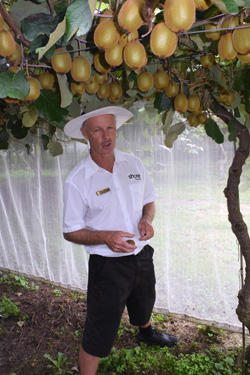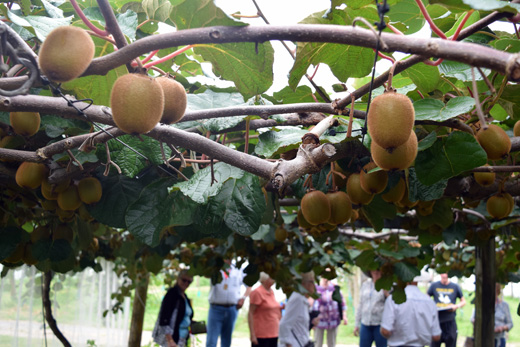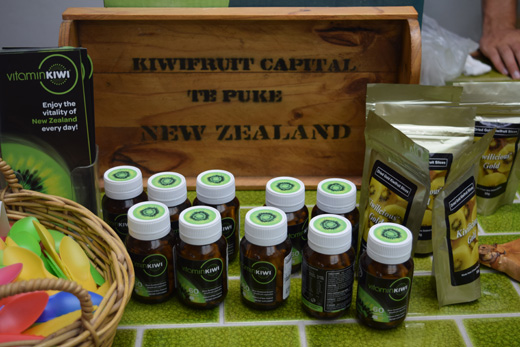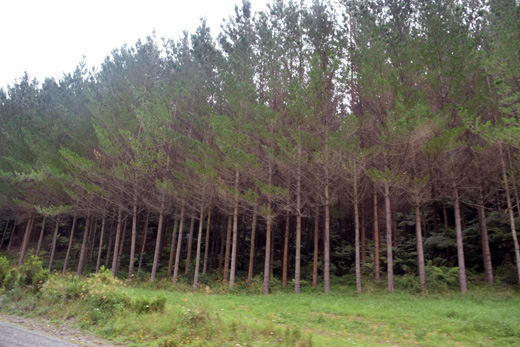Editor’s Note: This is the 19th in a series of stories researched during Don and Nancy Harrison’s 50th Wedding Anniversary cruise from Sydney, Australia, to San Diego. Previous installments of the series, which runs every Thursday, may be found by tapping the number of the installment: 1, 2, 3, 4, 5, 6, 7, 8, 9, 10, 11, 12, 13, 14, 15, 16, 17, 18
By Donald H. Harrison


TE PUKE, New Zealand – As our guide Richard Nicholson lectured, I realized that the story of my grandfather, M. Joseph Harrison, had a lot in common with that of the kiwifruit, which is one of New Zealand’s major agricultural exports.
Kiwifruit used to be called Chinese Gooseberries. “The name was changed in the 1960s or ‘70s,” said Nicholson. “It worked out well for New Zealand marketing. China wasn’t the most popular country back then” so by renaming the sweet tasting fruit “kiwifruit,” it gained more acceptability in the United States and international markets.
In 1909, my grandfather, then named Meyer J. Harowitz, was an architectural student, looking forward to earning his professional degree, and going to work in New York City. In his time when anti- Semitism was rife, he knew that some potential clients would never ask him to bid on a project, no matter how creative his designs might be. So, along with his father, Velvel, he changed the family name from Harowitz to Harrison. Velvel became William Harrison, and Meyer Joseph Harowitz became M. Joseph Harrison.
Just as the name change was a beneficial marketing strategy for the kiwifruit industry, so too was it beneficial for my paternal grandfather, who became a successful residential architect. His home designs made him a nice living. My father, Martin B. Harrison, was born in 1910 with the Harrison name, and there have been three generations of Harrisons since then.
After China decided to pursue a softer version of Communism than Mao Tse-tung’s brand, it became more popular with the other countries of the world. But by this time, the kiwifruit name had taken hold and no one in New Zealand seriously proposed changing the name back to Chinese Gooseberries. Similarly, after anti-Semitism subsided in the United States (although it seems on the rise again on college campuses), no one in the Harrison family seriously proposed becoming Harowitzes again.
The kiwifruit/ Chinese Gooseberry had a completely different sounding name in the original Chinese, just as Harowitz probably was not my family’s original name. From biblical times up to about the Napoleonic era (early 19th century), Jews typically called themselves “so-and-so, son of so-and-so,” for example “Isaac ben Abraham.” With all those “bens” running around with similar sounding names, it was very difficult for European tax collectors to keep everyone straight. Napoleon offered Jews citizenship in his Empire if they would take last names. Typically, the names they chose were after things found in nature (eg, “Rose”), or patronyms, (eg, Abrahamson), their towns (eg, Hamburger, Warschauer), or their professions (eg, Schneider, which means Tailor). Harowitz is a variant of Horowitz, which is said to be derived from the Czech town of Horavice. The family may once have lived in Horavice, but so far as we know, prior to immigration to the United States in the late 19th century, the family lived in Lithuania.
Getting back to the kiwifruit grown in the Te Puke (Maori for “The Hill”) region of New Zealand’s North island …
Our bus driver/ guide Nicholson was quite knowledgeable about kiwifruit because over a lifetime that has included several interesting jobs, he also has helped to pick and pack kiwifruit. A resident of the port city of Tauranga, located about 17 miles southeast of Te Puke (pronounced teh-pook-eh), Nicholson told us that during the packing season, the kiwifruit industry needs 20,000 workers, and not nearly enough New Zealanders are interested or available for this kind of work. So, New Zealand imports temporary workers from such low-wage countries as Samoa, India, Bangladesh, and Thailand, issuing to them cards that permit them to work only in agriculture. When the March-April-May picking season is over, the workers go home, as it is unlawful for anyone to employ them at other jobs.
At the orchard in Te Puke that we visited, there were both green and gold kiwifruits. The gold tastes sweeter than the green. I asked one of the supervisors at the orchard whether they’ve ever created a hybrid of both varieties. No, he responded, but there are over 150 varieties of kiwifruit that have thus far been tested for such attributes as taste, longevity, size, shape, color, and texture. “The next one we will develop is one where the skin is easy to peel or easy to eat, because the skin of a kiwifruit now is unpleasant, especially with the green,” he said. “The gold is a little better.”
“We want you to be able to purchase your kiwifruit and be able to eat it on the way home,” the supervisor said.
The idea, he added, will be to make the kiwifruit have a peel like a banana, or an edible skin like an apple.

Nicholson pointed out that kiwifruit grow on long vines which are folded over the top of a three-sided trellis, so that the fruit can be picked easily. Another benefit is this methodology gives the vines at the top of the trellis plenty of sunshine, which kiwifruit plants crave. A problem in Te Puke is that it can get very windy, so typically tall bushes are planted along the perimeter of the orchard to protect the kiwifruit from the wind. It is a balancing act, because growers do not want to deprive the kiwifruit of sunlight in the process.
Near the orchards, one also can see windmills, which are turned on to circulate the air in the case of frost. When the air is circulated, it warms up, which can help to save the crop. After kiwifruit are picked, sorted and packed, it is shipped by train to Auckland or Tauranga, from either of which it can be sent to international destinations.
When refrigerated at 35 degrees Fahrenheit (3 degrees Centigrade), kiwifruit will retain its flavor for approximately a year, Nicholson said, which is one reason why it is such a good product for export. The orchard we visited had a gift shop with a variety of product made from kiwifruit as well as a tasting room, and “the fruit there was picked nine months ago,” Nicholson said

There are four times as many female kiwifruit plants as male plants in the orchard. The males don’t produce fruit, so except for purposes of pollination, the males are less desirable than the female plants. Bees are brought in November to pollinate the plants; they fly from the flowers on the male vines to those on the female vines.
In Te Puke, the kiwifruit does not need irrigation; annual rainfall is about 50 inches a year, more than enough to do the job.

Between Te Puke and Rotorua (Maori for “Second Lake”) are large pine forests, which grow to maturity in 25 years– very quickly compared to lumber in other countries. The pine logs are transported to the port of Tauranga (pronounced without the “g” so that it rhymes with piranha), and from there shipped, for the most part, to China, which converts the pine lumber into cardboard to be used in shipping its various plastic manufactured products.
*
Harrison is editor of San Diego Jewish World. He may be contacted via donald.harrison@sdjewishworld.com
Pingback: Sisters are leaders in Auckland Jewish community | San Diego Jewish World
Pingback: Dance, carvings, geysers high points of Maori village | San Diego Jewish World
Pingback: Movies at sea enhance the cruise | San Diego Jewish World